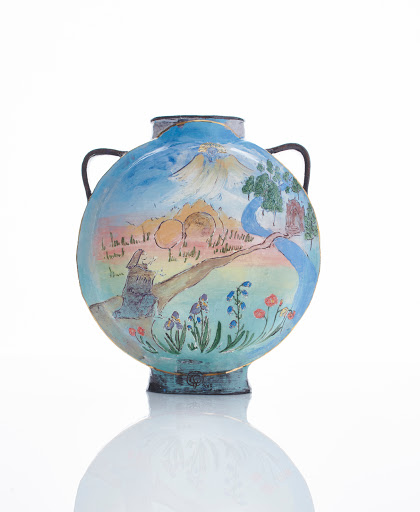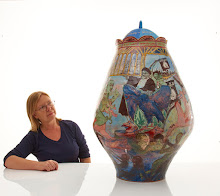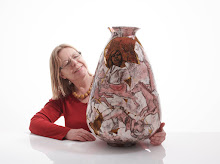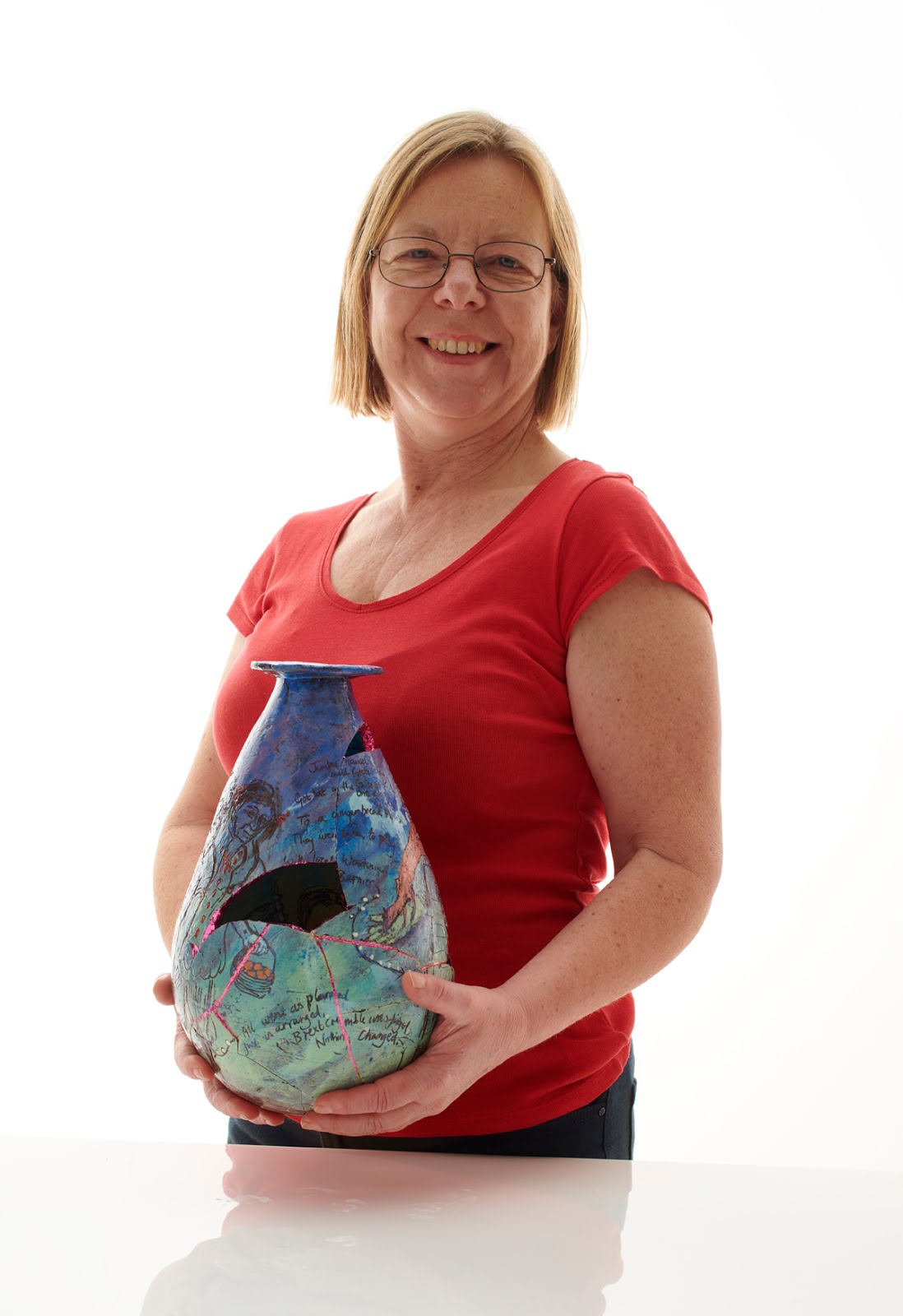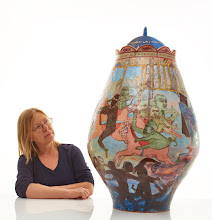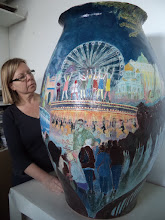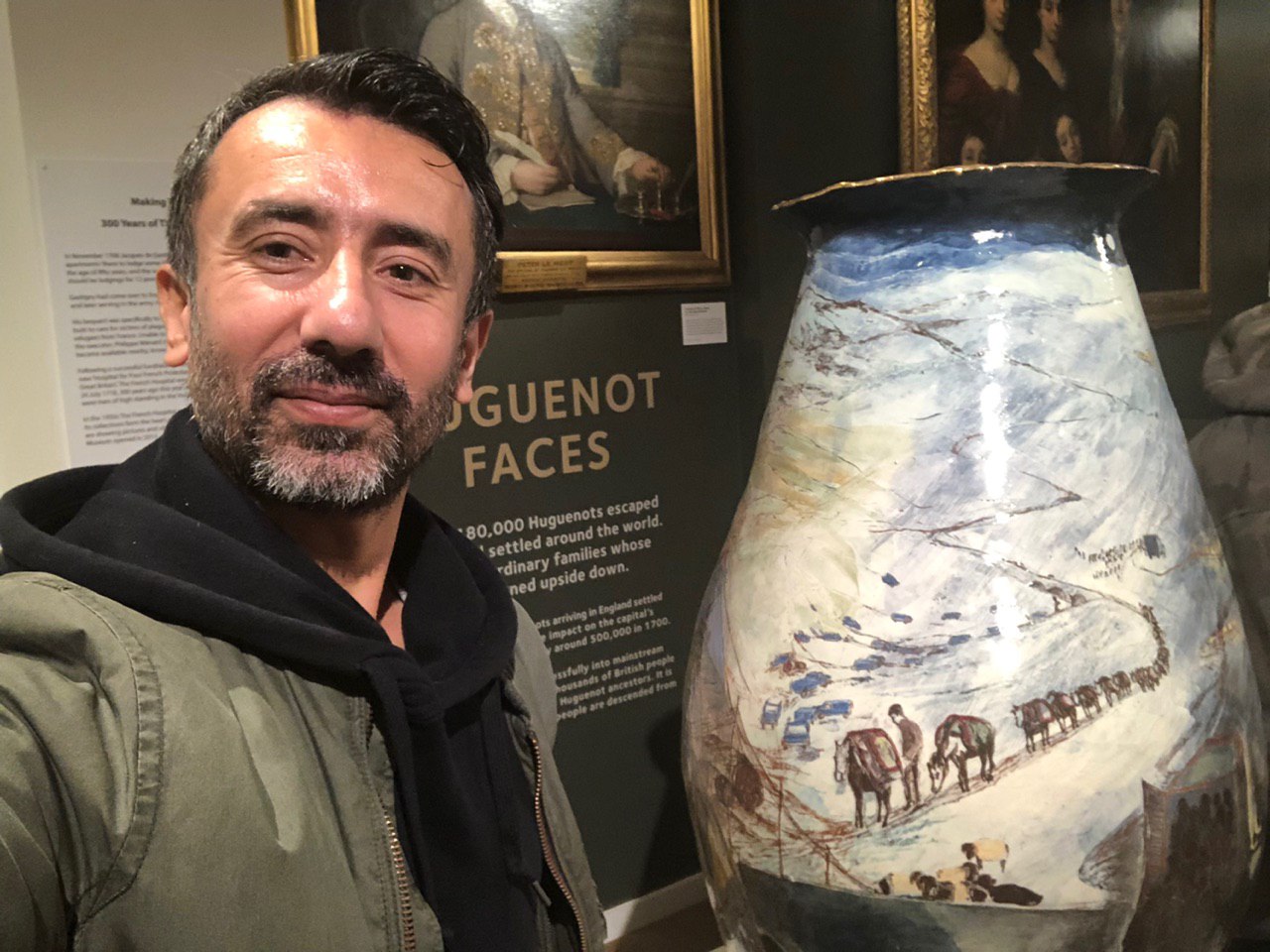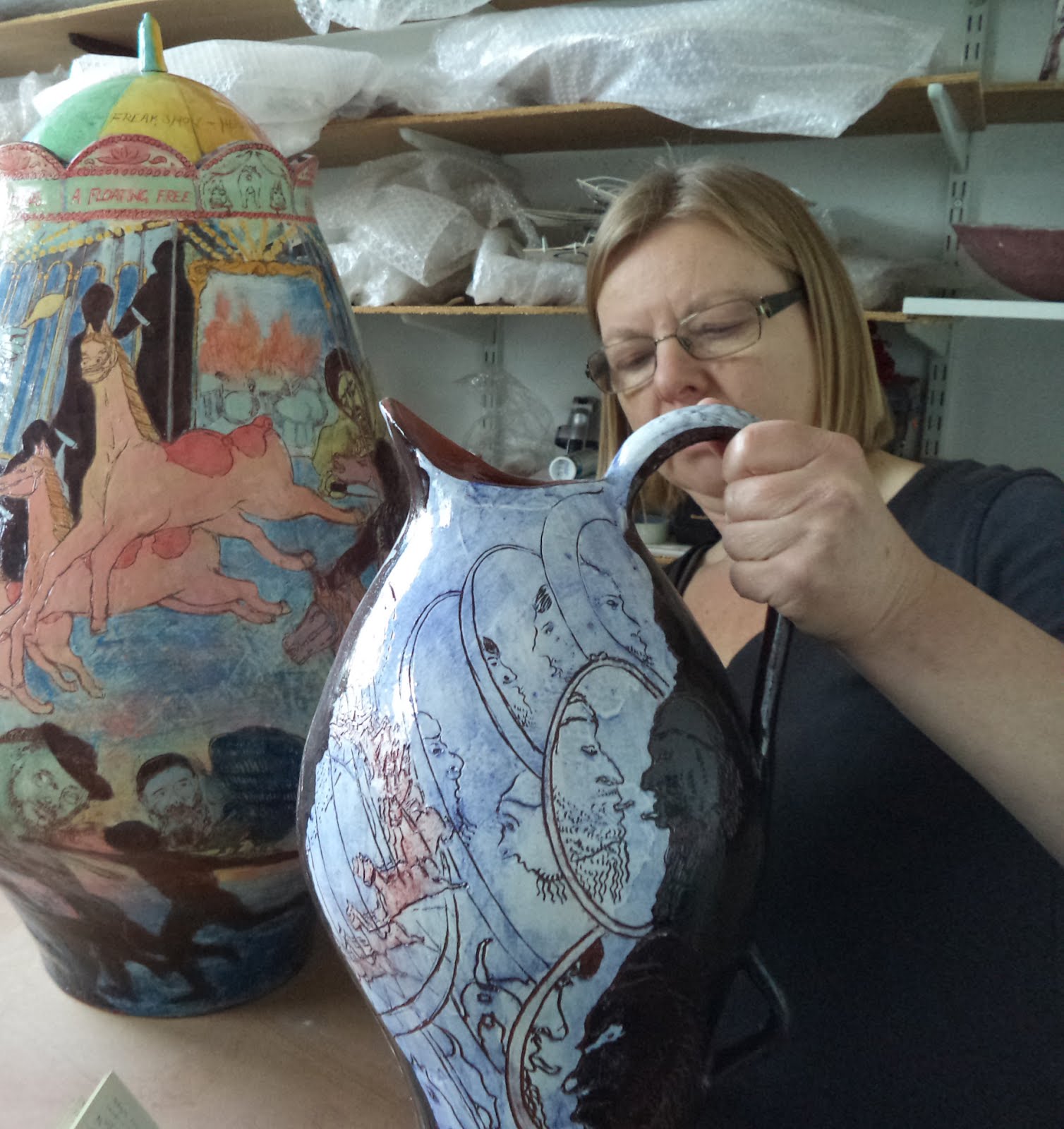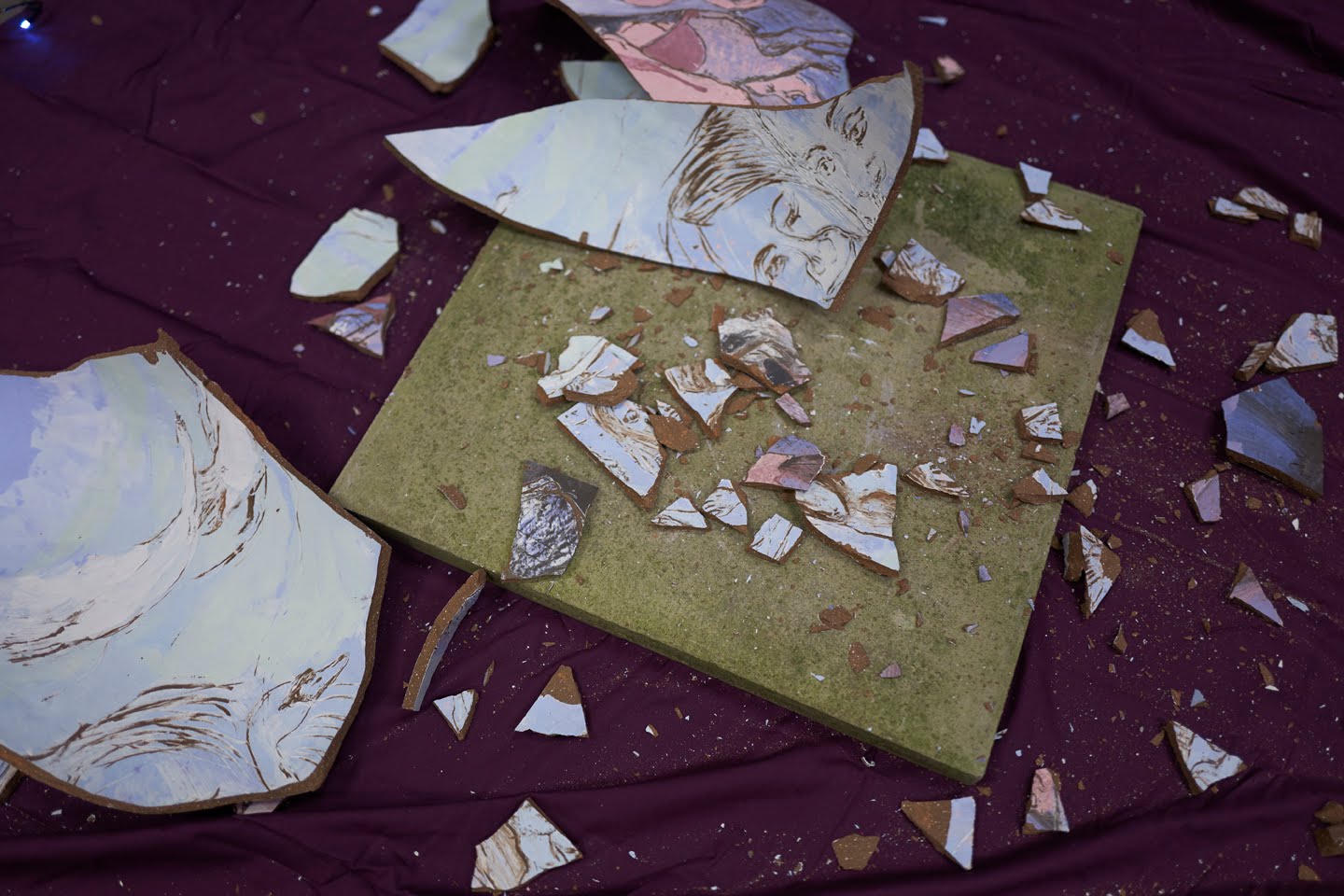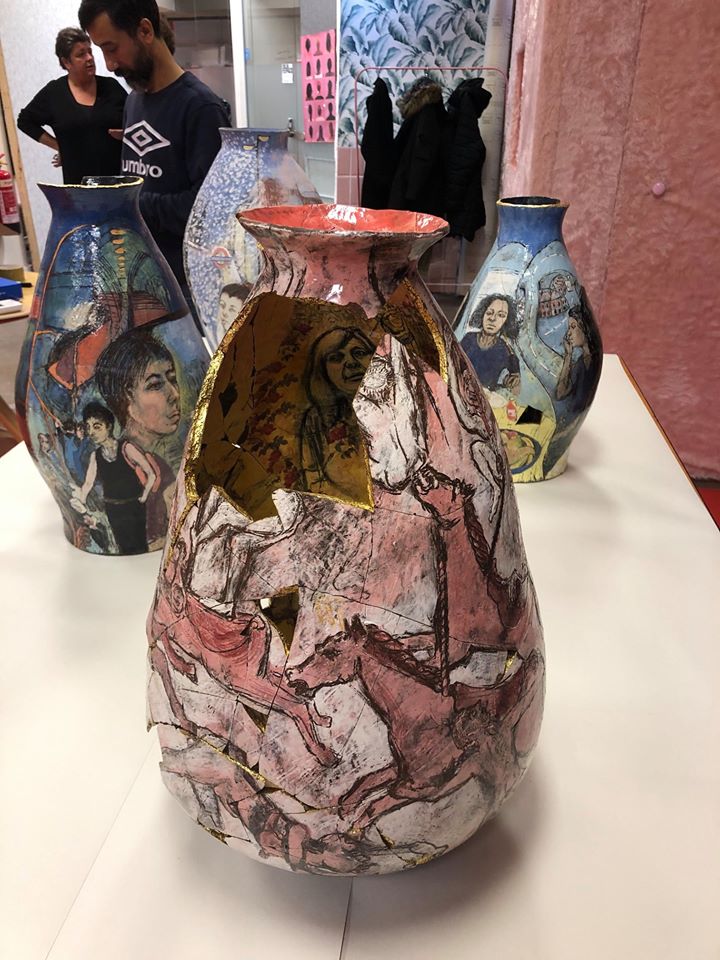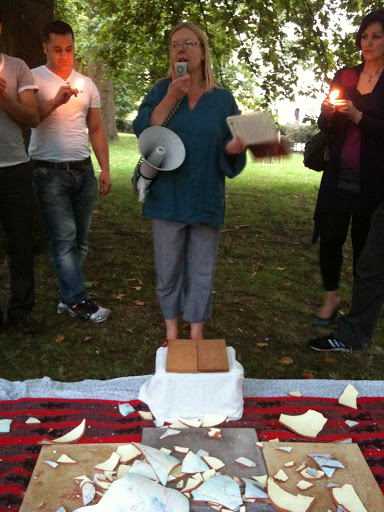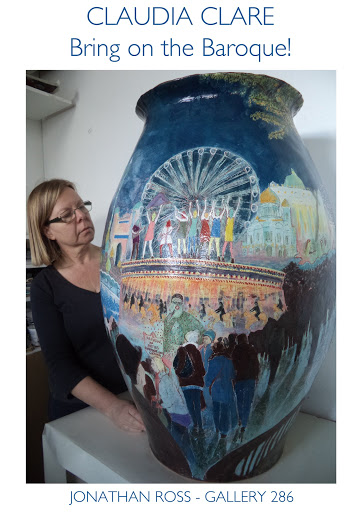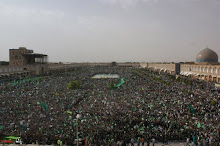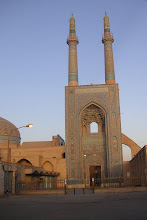'Ooooh how I love those stout German stoneware jugs,' I crooned, leaning into the display case to admire every twirl of oak leaf and branch on the rough brown surface. Then other decorative motifs swam into my vision: bloody Alan Measles again. I'd been had. It wasn't a 'genuine' stout German pot, it was a genuine Grayson Perry, pretending to be one. Round the display case I went and found the ribbon's of text, stamped into the clay surface using old printing letters, setting out a ludicrous rhyme which I no longer recall, but it made me laugh out loud. The best thing about this show is that you often can't tell at a glance, which works are 'proper museum objects' and which are Grayson Perry's museum objects, and the other best thing about this show, if that's possible, is that it will make you laugh out loud many times, and it's not often you can say that about contemporary art, let's face it. Alan Measles, that ubiquitous teddy bear, cavorts with angels and devils, with soldiers and horses. He is a knight astride his mount, standard and shield at the ready, he is a votive object in a shrine, with erect penis with a flower in it, holding hands with Claire, dressed, as she so often is, in headscarf and A-line skirt. Both of these works are cast in metal but the shrine has a ceramic tile at the back, painted with the image of a female black smith. Perry uses iron for most of the metal work in this show- it is the material of the forge, of industry and of craft for industry, a concept Perry expresses well, not least in the first exhibit, one of his motorbikes, which is outside the gallery with a shrine on the back with another teddy bear in it.
The selection of the Museum's votive and spiritual objects is magnificent and Perry's works respond to these objects effortlessly and work their way in among them, threading his own mad story of the life of his god-bear and his attempt to establish himself as a contemporary deity. He encounters everything from religious tourism to celebrity, 24 hour news and social networking and scowls at all of it. The pots are as gorgeous and as funny as they always are, mixing that lucid graphic hand with layer upon layer of collaged imagery, dense and dark at times. The final piece of the show, the boat with the casts of crafted objects and the bottles of sweat, blood and tears lashed to its mast, is a fabulous object, (in all senses of the word,) cast in Iron, lyrical and mythical, utterly convincing and deeply eccentric all at once.
I had thought that Grayson Perry's best show to date was The Charms of Lincolnshire, where he created a collection of works responding to a rural, agricultural and domestic museum collection. The Tomb of the Unknown Craftsman continues and develops this theme but with a much greater emphasis on the talisman, the votive and the ritual object. It probably tops the earlier show. It's wonderful, moving and funny. Go and see it!
Tuesday 20 December 2011
Saturday 24 September 2011
Origin - in Turbulent Times
The Autumn Equinox has brought with it an atmospheric change. An economic year of bumbling along, sort of hoping things might improve has suddenly blown up into a maelstrom of recrimination, anxiety, market chaos and talk of recession round two. Origin, now in the beating heart of trendy art-world East London, oozed confidence by contrast. It hummed with activity which, I hope, was an indicator of people deciding to spend money on well made, long lasting objects they would love.
Origin is vast, overwhelming in some respects. You can't look at everything unless you have all day and a substantial reserve of energy. I go there for the ceramics and, to some extent I notice the metalwork and furniture too. Jewellery, textiles and sundry other weird-looking accessories interest me not one jot and, these days, with limited time, I simply edit out of my vision all that does not immediately engage. This year, I looked only at the ceramics and, for the first time, bought things. It's my new project - kick-starting the economy.
Sophie Woodrow's porcelain dream-world beasts made an enticing reception committee. With hollow eyes and strangely clad in unlikely costumes, they stood on their hind legs, those that had them, and stared and I stared back. An owl with antlers, covered in miniature toad-stools, a bull with a lowered head and large bow, hedgehog-like creatures and rabbity things - all called out mournfully for attention. It was astonishingly affecting and surprising too - a relief not to encounter more of the vicious bunnies intended to subvert or shock but, instead, something quietly and genuinely moving.
Aneta Regel-Deleu had a gorgeous collection of new work - weird bone-like structures, half live, human, and growing but also surreal and anything but human, in their skins of ferocious-coloured glaze - matt powdery pink, bright orange gloss and vicious yellow.
Then came the tableware, which is where I got out my debit card. First stop, Sun Kim, her sleek, oatmeal coloured stoneware has evolved into a fine collection of supremely elegant tableware. I sulked when I found no mugs with handles. 'A disastrous firing,' she explains, and promises me mugs at her forthcoming open studio. I make a mental note to reserve enough money for one of her teapots too. On to Linda Bloomfield's stall where a lovely new lemon yellow glaze attracts me and I buy a mug, tall and straight. She's also developed a new mushroom coloured glaze. 'Men didn't buy my work until I made the 'grey,' she explains.' She's talking to a woman from London Potters Association who's taking copious notes and questioning every potter closely, particularly about sales. Origin, according to Linda, delivers the goods. Hooray! So I'm not the only one determined to kick our sluggish economy up the ass then.
Finally, it's Chis Keenan. Lately he's been making delicious Temmoku glazed work with sky blue insides and sure enough - he has mugs. Mugs! Proper mugs with handles - he's one for the Japanese aesthetic which is all very fine if you're Japanese but I'm English, very English, and I like a good stout mug for tea, brown tea - and I've always had my doubts about blue with brown. However, to my surprise, I find myself selecting a mug with a handle and buying it. Someone had asked him to put a handle on a tea-bowl apparently - and damn sound advice it was too. I don't hold with this tea-bowl nonsense. The colour is gorgeous. Ok, so the Temmoku is a wee bit marmitey and the handle's a bit fussy - Keenan's a tad over-crafted for my tastes but this is proper mug-shaped mug and I wasn't going to pass up on the opportunity - I do love that black/ blue mix. I needn't have worried about the blue / brown tea look. It works perfectly. The tea just reaches up near the rim where the black of the Temmoku is bleeding into the blue and it's just exactly right. Looks like a turbulent Autumn day in fact. Slurrrp. That's better - and silky smooth too, enough to calm the most jittery nerves, even those of the markets.
Origin is vast, overwhelming in some respects. You can't look at everything unless you have all day and a substantial reserve of energy. I go there for the ceramics and, to some extent I notice the metalwork and furniture too. Jewellery, textiles and sundry other weird-looking accessories interest me not one jot and, these days, with limited time, I simply edit out of my vision all that does not immediately engage. This year, I looked only at the ceramics and, for the first time, bought things. It's my new project - kick-starting the economy.
Sophie Woodrow's porcelain dream-world beasts made an enticing reception committee. With hollow eyes and strangely clad in unlikely costumes, they stood on their hind legs, those that had them, and stared and I stared back. An owl with antlers, covered in miniature toad-stools, a bull with a lowered head and large bow, hedgehog-like creatures and rabbity things - all called out mournfully for attention. It was astonishingly affecting and surprising too - a relief not to encounter more of the vicious bunnies intended to subvert or shock but, instead, something quietly and genuinely moving.
Aneta Regel-Deleu had a gorgeous collection of new work - weird bone-like structures, half live, human, and growing but also surreal and anything but human, in their skins of ferocious-coloured glaze - matt powdery pink, bright orange gloss and vicious yellow.
Then came the tableware, which is where I got out my debit card. First stop, Sun Kim, her sleek, oatmeal coloured stoneware has evolved into a fine collection of supremely elegant tableware. I sulked when I found no mugs with handles. 'A disastrous firing,' she explains, and promises me mugs at her forthcoming open studio. I make a mental note to reserve enough money for one of her teapots too. On to Linda Bloomfield's stall where a lovely new lemon yellow glaze attracts me and I buy a mug, tall and straight. She's also developed a new mushroom coloured glaze. 'Men didn't buy my work until I made the 'grey,' she explains.' She's talking to a woman from London Potters Association who's taking copious notes and questioning every potter closely, particularly about sales. Origin, according to Linda, delivers the goods. Hooray! So I'm not the only one determined to kick our sluggish economy up the ass then.
Finally, it's Chis Keenan. Lately he's been making delicious Temmoku glazed work with sky blue insides and sure enough - he has mugs. Mugs! Proper mugs with handles - he's one for the Japanese aesthetic which is all very fine if you're Japanese but I'm English, very English, and I like a good stout mug for tea, brown tea - and I've always had my doubts about blue with brown. However, to my surprise, I find myself selecting a mug with a handle and buying it. Someone had asked him to put a handle on a tea-bowl apparently - and damn sound advice it was too. I don't hold with this tea-bowl nonsense. The colour is gorgeous. Ok, so the Temmoku is a wee bit marmitey and the handle's a bit fussy - Keenan's a tad over-crafted for my tastes but this is proper mug-shaped mug and I wasn't going to pass up on the opportunity - I do love that black/ blue mix. I needn't have worried about the blue / brown tea look. It works perfectly. The tea just reaches up near the rim where the black of the Temmoku is bleeding into the blue and it's just exactly right. Looks like a turbulent Autumn day in fact. Slurrrp. That's better - and silky smooth too, enough to calm the most jittery nerves, even those of the markets.
Wednesday 17 August 2011
Johara Dance Company present: Hoochie Coochi Girls
Hoochi Coochi Girls, the latest production from Johara Dance Company, is a complex, evocative, and technically brilliant extravaganza, showcasing contemporary Middle Eastern dance at its best. Forget those uncomfortable, attenuated bellydancing performances you’ve seen in restaurants and nightclubs or even the polished displays of a handful of moves in music videos; Hoochi Coochi Girls mines a rich seam of dance history and treads a vast and ambitious cross-cultural terrain, challenging comprehensively the limitations imposed by the notion of an ‘authentic’ Middle Eastern dance. The show encompasses classical Egyptian, Oriental and folkloric dances in part one, through contemporary urban Hiphop, to interludes of early twentieth century cinema and music hall, to some magical nightclub fusions in the closing scenes.
Sailors and Sequins
The show is in four parts with the opening scene set in a port in Alexandria. It is a bright, cheerful good natured, dance banter - a theatrical portrait of dockside life. Awash with glitter and colour, a series of set pieces and solos tell a story of life at the social margins. We encounter women with baskets of wares to sell, women with bodies to sell, women with airs and graces to disapprove of everyone else, and a group of disreputable sailors who provide comic interludes and lewd commentary. Stunning group dances with full ‘corps-de-bellydance’ ensemble, faultlessly choreographed and performed, set the standard: a sharp and punchy Malaya Lef contrasts with the liquid elegance of the veil dances while a music-hall style hornpipe by the sailors adds variety and theatricality which shapes the entire evening.
Loss and Longing
The second part, Gypsy Life and Immigrant Love, sees a dramatic change of mood and a complete departure from the norms of bellydance. A darker, heavier atmosphere produces a series of dances that are variously spiky, angry, bored, steeped in sorrow and, finally, fist-clenchingly optimistic – that desperate hope of the brutally oppressed. The defining scene is The Factory in which a line of dancers produce and reproduce each other’s moves in sequence, imitating the monotony, relentlessness and sheer bone-shattering exhaustion of the sweatshop. Startlingly original, it choreographs boredom and resentment, an emotional territory largely untouched by dance productions and studiously avoided by bellydancers. On either side of The Factory, are two dances exploring loss, yearning, grief and confusion. Bellydance meets Flamenco Jondo in Josephine Wise’s gorgeously intense performance of ‘I long for Jerusalem,’ a passionate expression of longing traditionally sung by Spanish Jews, and, rural America meets central Baghdad in Two Kids, which portrays the lives of two Muslim children, both shut indoors away from life-threatening hostility. Performed with extraordinary tenderness and grace and by Mayelle Roger and Trish Rapley-Giles, this deceptively simple dance was both deeply touching and immensely evocative. The section ends with a ebullient Bollywood Hiphop fusion choreographed by Nuxya Nereisidos, and performed with razor-sharp precision.
Hollywood Spectacle
Part three, The Golden Age of the Movies, (see video of Arras performance at 1.20) is a return to classical oriental dance and costumes but now the entire performance is imbued with a golden haze of soft-focus, cinematic fantasy. It opens, in spectacular contrast to the preceding section, with a romantic, dewy-eyed performance by the whole cast, in glistening white, fairy-princess style costumes and enormous smiles. Margaret Krause’s choreography, which defines this section, captures the enchanted, dreamworld innocence of the period to perfection.
Masques and Swords
The fourth and last part, Masked Ball, performed in electric blue and pink with black masks, retrieved the accented spikiness of some of the earlier dances. The centre piece of this section was a breathtaking sequence of pure theatre which silenced the audience as ‘Kali’s Militia,’ (video at 1.47) choreographed by Gwen Booth, completely reinvented the traditional sword dance, introducing mystery, magic and fury as the dancers lined up and the swords took on the look of a terrifying, mythic beast. More fluid though no less terrifying was the moment the group circled menacingly, each dancer raising her curved sword above her head such that the blades themselves appeared to dance, rising and falling in sequence like wave, driven by their own fierce beauty. It was one of those unforgettable theatrical moments that will live in my memory forever.
What sets Hoochi Coochi Girls apart from all other bellydance shows I’ve seen, and places it in a class of its own, was the originality and scope of the choreography, the immense visual contrasts, the ambitious emotional range, and the flawless conviction with which all the dances, solos, duets and set pieces were performed. The grand finale, a mass of colour, light and splendour, drew extensively on the techniques of Sorcha Ra, Johara’s resident fire dance and poi expert and a recent addition to the company. A mix of veils, vast flaming fans, and flags, or ‘poi,’ swirled through the air, closing a truly audacious and unforgettable performance.
Wednesday 22 June 2011
Two Fingers and High Five: The Harrow Ceramics degree show, 2011
Image from installation by Cami Cabra and Sally Szczech
If your University and your government decide to close down your art course – what do you do? Well you mount the most impressive degree show ever, obviously.
17 ceramicists conspired to put a massive two fingers up to the head of school (absent) and the vice chancellor, (absent) and the entire demolition government to show them exactly what would be missing. Their work ranged from handsome, thrown bowls, (Jo Beckett), to a ‘shit machine,’ (Lawrence Epps), which oozed strands of clay in the most scatological way imaginable - not so hard with terracotta clay perhaps, but it provided much amusement to attendant children, to say nothing of the adults. It turned out that the extruder had been carefully adjusted to produce strands which, when cut in cross section, had a human profile. The massed human profiles were then arranged in an office, a London tube, and in various other groups, busying themselves on shelves and so on. Brilliant!
Hats off to Colin Wainwright for a witty installation and for corresponding economy in his artists statement: ‘An exploration of the inappropriate.’ It was too, - I especially loved the skeletal wine glasses. I also enjoyed the quiet two fingers to mighty dynasties of craft ceramics. Jane Cairn’s gorgeously proud celebration of industry, of how things work, of process and mechanics, occupied the space magnificently. It dominated the entrance to this giant, underground car-park of a 'gallery' and mixed effortlessly with the masses swarming round the drinks table at the private view.
Downstairs, clearly enjoying the acres of space available, the rest of the artists spread their work to full advantage. Naomi Wayne’s ceramic chairs, with the words of an Arab protest poem printed on to their seats, were placed in disarray in front of a slide show of photographic images from Palestine – a potent mix of fury and something more elegiac but still everyday. Contemporary art is littered with clichés on the subject of the Arab –Israeli conflict and most often, unfortunately, by artists whose ignorance is outweighed only by their dullness. Wayne’s finely tuned mix of hard edged, unyielding anger with humour and poetic vision is a very welcome redress.
The notion of craft and memory, deployed by Sally Szczech in ‘Heirlooms,’ is also a well trodden path but she succeeded in bringing a fresh visual and tactile element to her work, particularly with chest of drawers filled with sewing materials, including printed ceramic cotton reels. It was immensely appealing and really brought out the nosey, inquisitive side of the audience. Everyone seemed to be fiercely resisting the desire to have good rummage around. Not all succeeded.
I have focused on five of the artists in the show but all of them, produced highly original and professional work – there really wasn’t a dud one among them and there are plenty more I could have singled out. So, hereis the link to their collective website with all their names, images and briefest of artist’s statements. Look out for any one of them. You will be richly rewarded.
Monday 24 January 2011
Lamentations 2010 Rachel Kneebone at White Cube
Pictured above is an earlier work from an exhibition at The Barbican in 2010 - it gives a good idea of the way she works around the plinth.
Lamentations: Rachel Kneebone at White Cube
An exhibition of glistening white porcelain works, mounted on giant, monumental plinths, theatrically lit in a darkened room with painted black walls and called, ‘Lamentations,’ states unequivocally that you must take it seriously. You should approach with due solemnity and appropriate hush, and regard – probably for quite some time.
The title alone sounds literary. Add the theatrical staging and it suggests a Greek Tragedy. Actually being in the gallery, surrounded by the six Lamentations, felt more like being in a church awaiting Benediction or the Stations of the Cross, such was the depth of reverence in the atmosphere.
Even now, it is hard to say if these works lived up to their onerous atmospheric conditions. They are magnificently made and produced by an artist who knows her material intimately and who casts aside all anxieties about self-conscious knowingness and the need to make satirical references and, instead, takes the risks required to stride, apparently without fear, into an unlikely world of large-scale porcelain statuary.
I say ‘statuary’ because the six Lamentations seem to imitate statues. The porcelain in these works is playing the part of marble. They resemble the marble figures on graves and tombstones. They are each made up of a mass of writhing porcelain figures, doll-sized and mounted on porcelain plinths and glazed. Though the individual works are small, table-top sculptures, they read as large-scale because of the way they have been displayed. The porcelain pieces, including their plinths, are placed on another white plinth, which is itself placed on a black plinth, adding to the overall stagey effect. They imitate the tumbledown-ness of Victorian cemeteries. The porcelain plinths are cracking open and threatening to fall apart any minute. There’s a hint of eighteenth century gothic in the atmosphere.
‘As grave as the imagined as frivolous as the eternal,’ is the title of the first piece. It might be a pun, I assume it is, but the atmosphere was dictating due seriousness, so perhaps not. They all have long literary titles. A distorted figure with extended legs and weird oozing toes is draped over the knee of another distorted, faintly girlish figure. The pair is instantly reminiscent of Michelangelo’s Pieta and sits atop a wriggling mound of dismembered bodies and twisted, porcelain spaghetti-like strands. None of the figures have heads, or, if they have something in place of head, they have a vagina or a penis.
The plinths are an essential part of the narrative. Some are overtly tomb-like, cracking open and releasing the vile spirits, while others are barely discernible amidst the swathes, festoons and yet more ecstatic distorted figures. All the figures have either enlarged vaginas or vagina or penis heads. Some have small breasts with agonising torsos which resemble enlarged ribs or hands gripping and squeezing the body. There is an innocence in the girlish legs and arms, in the bottoms and feet and something tortuous in these finger-rib torsos.
Inevitably the vagina and penis heads are a reminder of the Chapman brothers’ rubbery confections and of the cartoon grotesques of Breughel. Kneebone’s references derive from three sources: ceramics, sculpture and painting. The Meissen shepherdesses are present, and the Sevres swathes and flowery festoons, as are the tortured souls of Italian Renaissance sculpture. What is interesting though is that she does not seem intimidated by any of them; there is no sense of genuflection. She certainly isn’t subverting them she seems to be saying, ‘yes, this looks like a Chapman figure and that looks like the foot of a Meissen shepherdess, the ankle of a Renaissance religious figure, the twirl of a Sevres swathe, but never mind all that, just follow these wounded souls into their torment or sorrow.’
I wasn’t entirely convinced but I’m still open to persuasion. I’d like to see them ‘out in the field,’ in a Renaissance or even Medieval church or ruined abbey. They don’t need those dutiful titles and I’m not sure they need all that theatre. They need to breathe air. For all the death and the sorrow and the lament, they are, very much about life. They teeter on the edge of ridiculous but that might be a strength. It’s just too easy to dismiss work like this, with the titles and the grandiose display, as absurd, pompous, overblown and, yes, ridiculous. The catalogue essays, though blisteringly professional and academically proper, don’t help. Partly because neither writer sounds entirely convinced either.
That said, David Elliott’s essay is very convincing in places. He discusses in particular Kneebone’s interest in realising female sexuality in art – wresting it from the persistent image of ‘lack’ and ‘absence.’ It is a detailed, involved, and sometimes passionate essay - so perhaps he is convinced – but here too, it is possible to over-write just as much as it is to over-display.
Kneebone is producing highly original, risky, substantial works. She uses porcelain in visceral, exciting and unorthodox way – mixing moments of studio pottery, (spaghetti strands and roses), moments of industrial production, (bottoms and feet), and moments of immensely Proper Sculpture. Putting aside the inflation and the derivation, they deserve and they reward serious contemplation.
Subscribe to:
Posts (Atom)




